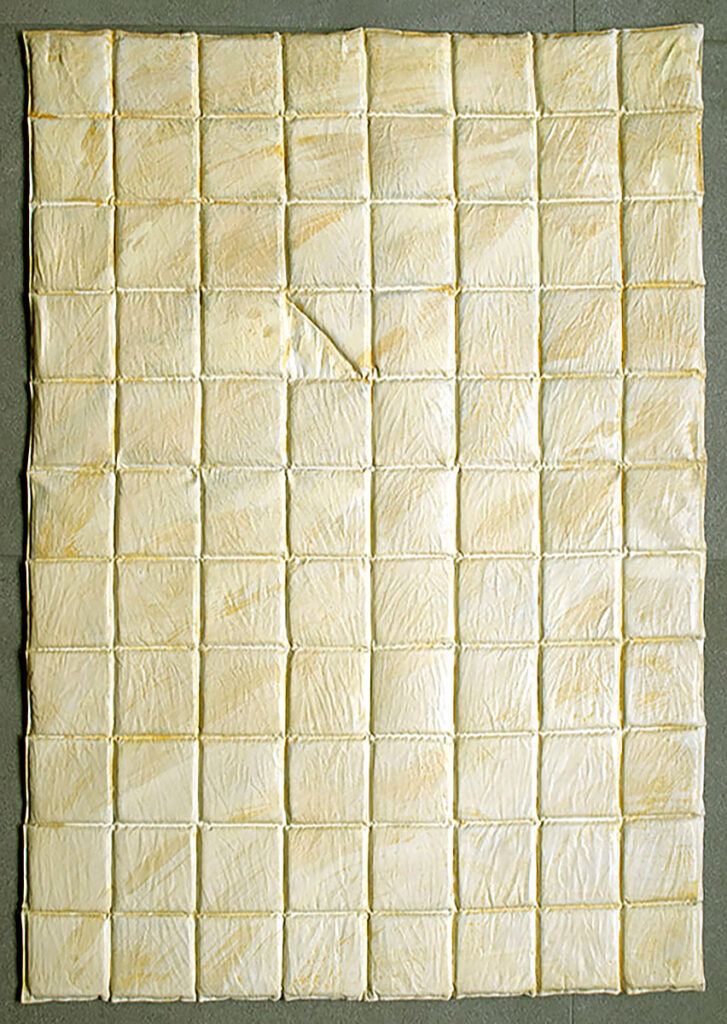Marian Meško is a solitaire at the Slovak art scene, a painter with “focused and internal intensity” (Peter Zajac). His work is usually based on the technique of frottage. He often supplements traditional with expressive gestures or destructive interventions like erasing, redrawing, sticking, stitching or casting. Some of the characteristic features of his works include the reduction of visual elements, the use of various surface structures, layering of materials, monochromatic color schemes (specifically shades of black, grey, ocher and brown). Meško moves freely between various artistic styles of the second half of the 20th century; from minimalism and abstraction to informel and analytical painting. His works mostly deal with everyday reality, relationships and tradition. His lack of figurativeness is compensated by narratives that reflect upon the real world that exists outside the walls of the artist’s studio. Meško’s works create an unusual perspective that is based on the relationship between a fragment and the entirety. They create a meditative atmosphere that does not reflect upon the outside but rather the inside – they represent “traces of internal landscapes” (Peter Zajac).
The work titled Pavement – Softened has become one of the latest acquisitions in the collection of the Nitra Gallery. It belongs to the Softened series that Marian Meško was working on in the 1980s. Its form and content are a follow-up to his previous cycle Transfers – a series of frottages that the artist altered using various gestures and destructive interventions in combination with different techniques like gouache, watercolor, pastel, pencil drawing etc. Frottage is a technique that is used to create an imprint of a textured surface by rubbing a sheet of paper or canvas with a pencil lead or paint. The technique was invented by accident in 1925 by the surrealist painter Max Ernst. Marian Meško’s Pavement – Softened is a frottage of a real pavement that has been transformed into a soft, stuffed textile with a stitched pattern. As the title suggests, this process softened the stone pavement not just physically, but also in regard to its color scheme that consists of soft ocher shades. The artwork links the natural with the artificial. On one hand, it connects the imprint of the pavement with traces of the artist’s handwriting that is the trace of the actual act of frottage, the stitching of the textile structure and the application of a new color palette. On the other hand, this unity can be perceived as a “humanization” of the natural material – the original stone pavement was made using industrial processes. One of the implied pavement tiles looks damaged as it seems to be partially missing. Meško leaves us uncertain whether this “imperfection” of the otherwise precise pattern was a part of the original floor or pavement (i.e. authentic), or whether it was later added by the artist in order to “humanize” the image (reflection/trace) of the everyday world we live in.
Marian Meško was born on November 13, 1945 in Prešov, Slovakia. From 1961 to 1965 he studied at the Secondary School of Applied Arts in Bratislava where he majored in advertisement and display design under Rudolf Fila and Štefan Schwartz. From 1965 to 1971 he studied at the Academy of Fine Arts and Design in Bratislava at the Department of Figural and Landscape Painting that was led by prof. Ján Želibský. He entered the unofficial art scene at the beginning of 1970s. He was joined by other artists who officially created the group called A-R in 1991. Its members included Klára and Milan Bočkays, Ladislav Čarný, Daniel Fischer, Vladimír Kordoš, Otis Laubert, Marián Mudroch, Dezider Tóth and the art theorist Jana Geržová. The title is derived from the French expression Avance-Retard that indicates where to move the regulator lever to speed up or slow down the rate of a watch. Until 1989, Meško was a freelance artist who exhibited at unofficial exhibitions, for instance at the premises of the Institute of Technical Cybernetics (later called the Institute of Applied Cybernetics at the Slovak Academy of Sciences in Bratislava), that were organized by František Mikloško. He also attended unofficial exhibitions and meetings in the Czech Republic. In 1989 he started teaching advertisement design at the School of Applied Arts in Bratislava. After November 1989, he joined the official art scene and exhibited at many group and solo exhibitions in Slovakia and abroad. In 2012 he curated a series of exhibitions for the Gallery 19 in Bratislava.
—Omar Mirza, May 2017
Bibliography
ZAJAC, Peter. 2005. Marian Meško. Prešov : Vydavateľstvo Michala Vaška, 2005. 148 s. ISBN 80-7165-536-8.
GERŽOVÁ, Jana (red.). 1999. Slovník svetového a slovenského výtvarného umenia druhej polovice 20. storočia. Bratislava : Kruh súčasného umenia PROFIL, 1999. 320 s. ISBN 80-968283-0-4.
Inventory No.: O 2166
Artist: Marian Meško
Title: Pavement – Softened
Year: 1983
Technique: combined
Material: combined
Dimensions: 82 × 59 cm
Signature: rear side, bottom right: in blue pen: MARIAN MEŠKO; “DLAŽBA – ZMÄKČENINA” [“PAVEMENT – SOFTENED”]; “87 A POL” [“87 AND HALF”]; KOMBINOVANÁ TECHNIKA [COMBINED TECHNIQUE]; JÚL 1983 [JULY 1983]; 82 x 59 cm; signature: Marian Meško; rear side, bottom left: in blue pen: VYSTAVENÉ [EXHIBITED]: GALERIE H; KOSTELEC NAD ČERNÝMI LESY; MÁJ 1987 [MAY 1987]; SEN O MÚZEU [DREAM ABOUT A MUSEUM]; POVAŽSKÁ GALÉRIA ŽILINA [MUSEUM OF ART ŽILINA]; JANUÁR –
FEBRUÁR 1991 [JANUARY – FEBRUARY 1991]
This acquisition has been supported using public funds provided by Slovak Arts Council. This document reflects the views only of the author, and the Council cannot be held responsible for the information contained therein.
